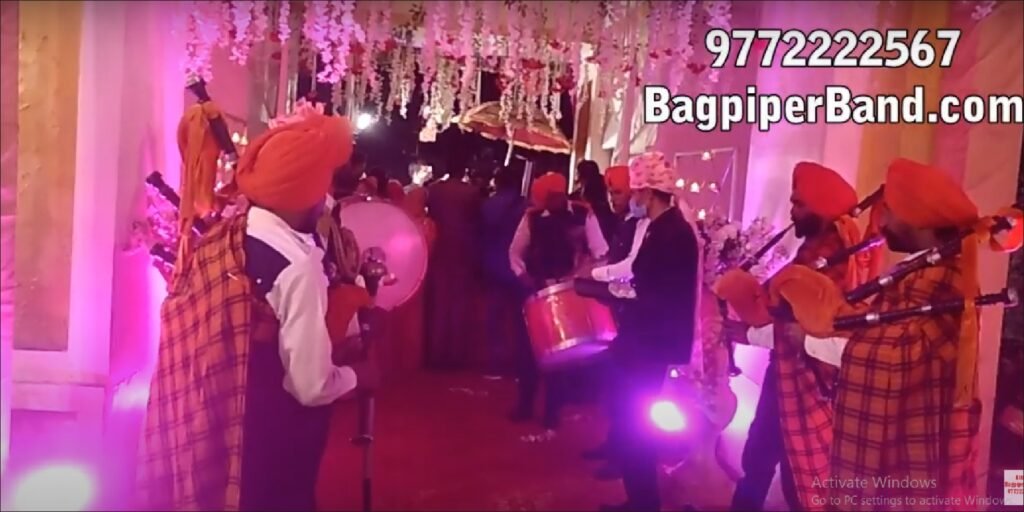Facts About Bagpipes: Unraveling the Mystique of This Iconic Instrument
Ever heard the soul-stirring wail of bagpipes at a wedding or parade and felt your heart skip a beat? There’s something magical about those haunting notes, like a call from another time. Bagpipes aren’t just instruments—they’re a cultural powerhouse, blending history, craftsmanship, and pure passion. From their ancient roots to their surprising role in Indian celebrations, bagpipes are full of surprises.
Whether you’re a curious newbie or a seasoned piper, these facts will deepen your love for this iconic instrument. Ready to dive into the world of bagpipes? Let’s unpack some fascinating truths!
Introduction to Bagpipes
What Are Bagpipes?
Bagpipes are like musical time machines, blending a bag, pipes, and reeds to create a sound that’s both bold and soulful. You blow air into a bag (leather or synthetic), squeeze it to push air through a chanter for melodies and drones for that continuous hum.
Originating centuries ago, they’re most famous in Scotland but have fans worldwide, including India’s vibrant pipe bands. Think of them as a musical dragon—breathing fire through every note, commanding attention at any event.
Why Are Bagpipes So Fascinating?
What makes bagpipes so captivating? It’s their ability to evoke emotion, from joy at a wedding to solemnity at a memorial. Their unique sound cuts through the noise, and their rich history spans continents and cultures.
In India, they’re a staple at baraats and parades, adding a regal vibe. Plus, the skill it takes to play them is like mastering a martial art—impressive and awe-inspiring. Let’s explore the facts that make bagpipes a global legend.
Historical Facts About Bagpipes
Bagpipes have a story that stretches back centuries, full of twists and turns.
Ancient Origins
Did you know bagpipes predate the smartphone by, oh, about 2,000 years? Some historians trace their roots to ancient Egypt or Mesopotamia, where reed instruments with bags were played around 1000 BCE. By the Middle Ages, they popped up across Europe, from Spain to Scotland. These early versions were simpler, often made with animal bladders, but they laid the groundwork for the bagpipes we know today. It’s like finding the great-granddaddy of your favorite gadget!
Evolution in Scotland
Scotland turned bagpipes into a cultural icon. By the 16th century, the Great Highland Bagpipe (GHB) became the star of clans, battles, and celebrations. Pipers played to rally troops or mourn the fallen, earning the instrument a sacred place in Scottish lore. The design we see today—three drones, a chanter, and a leather bag—solidified in the 18th century. It’s like the bagpipe found its groove in the Highlands, becoming the voice of a nation.
Bagpipes in India and Beyond : Facts About Bagpipes
Bagpipes aren’t just a Scottish thing—India loves them too! Brought by British colonial bands in the 19th century, they became a hit in military and police bands. Today, they’re a must at North Indian weddings, especially in Punjab and Rajasthan, where pipe bands lead baraats with swagger. Globally, you’ll find bagpipes in Ireland (uilleann pipes), Spain (gaita), and even the Middle East. It’s like a musical passport, crossing borders with ease.
Design and Construction Facts About Bagpipes
Bagpipes are a marvel of craftsmanship, built with precision and care.
Anatomy of a Bagpipe : Facts About Bagpipes
A bagpipe is like a musical octopus, with multiple parts working in sync. The bag holds air, the chanter plays melodies, drones add harmony, and the blowpipe lets you puff air in. Reeds inside the chanter and drones vibrate to create sound. Each part, from wooden pipes to leather bags, HX2, is crafted with care. In India, a full set costs ₹4,000-₹1,42,000, depending on quality. It’s a complex puzzle that sings when put together right.
Materials Used in Crafting : Facts About Bagpipes
Bagpipes are a blend of nature and art. Pipes are made from hardwoods like African blackwood or rosewood for rich tone, though budget models use plastic. Bags are traditionally leather (sheepskin or cowhide) but often synthetic now, like Gore-Tex, for durability in humid climates like India’s. Reeds come from Arundo donax cane, while mounts might be synthetic ivory or metal. Each material is chosen for sound and strength, like picking the perfect ingredients for a recipe.
How Bagpipes Produce Sound : Facts About Bagpipes
Ever wonder how bagpipes make that epic sound? It’s all about air and vibration. You blow air into the bag, then squeeze it to push air through the reeds in the chanter and drones. The reeds vibrate, creating the melody and drone notes. The chanter’s holes let you control the tune, while drones hum a steady pitch. It’s like a mini orchestra powered by your lungs, with each part playing a role in the symphony.
Cultural Significance of Bagpipes: Facts About Bagpipes
Bagpipes aren’t just instruments—they’re cultural treasures.
Facts About Bagpipes: Role in Scottish Tradition
In Scotland, bagpipes are like the heartbeat of tradition. They’re played at weddings, funerals, and Highland games, symbolizing pride and heritage. Piobaireachd, a classical style of piping, tells stories through music, while lively marches like “Scotland the Brave” get crowds moving. The bagpipe’s role as a war instrument, rallying clans, adds to its mystique. It’s a cultural cornerstone, like a flag waving through sound.
Facts About Bagpipes : Bagpipes in Indian Weddings and Events
In India, bagpipes add pomp to weddings and parades. Pipe bands, often in vibrant uniforms, lead baraats in Punjab and Rajasthan, blending Scottish tradition with Indian flair. Schools and colleges use them for marching bands, and they’re a staple at Republic Day events. A set of Great Highland Bagpipes (₹4,000-₹15,000) is a common choice for these high-energy performances, making every event feel like a royal affair.
Facts About Bagpipes: Global Presence of Bagpipes
Bagpipes have traveled far beyond Scotland. Ireland’s uilleann pipes, Spain’s gaita, and Brittany’s biniou show their global reach. In the Middle East, instruments like the zurna share similar roots. In India, Meerut and Delhi are hubs for affordable bagpipes, priced at ₹4,000-₹12,000 on IndiaMART. Their universal appeal lies in their ability to stir emotions, like a musical language everyone understands.
Facts About Bagpipes: Musical Facts About Bagpipes
The music of bagpipes is as unique as the instrument itself.
Facts About Bagpipes : Types of Bagpipe Music
Bagpipe music splits into two main vibes: piobaireachd and Ceol Beag. Piobaireachd is the soulful, classical stuff—long, intricate pieces like musical stories. Ceol Beag includes upbeat marches, reels, and jigs, perfect for parades or weddings. In India, Ceol Beag dominates baraats, with tunes that get feet tapping. It’s like the difference between a ballad and a dance track—both awesome, just different moods.
Facts About Bagpipes: Unique Playing Techniques
Playing bagpipes is like juggling while running. You’ve got to squeeze the bag, finger the chanter, and keep the drones humming, all at once. Techniques like birls (rapid finger rolls) and gracings (quick decorative notes) add flair. Strikes and doublings give rhythm and punch. Beginners often start with a practice chanter (₹600-₹2,000) to master these moves before tackling the full set.
Facts About Bagpipes: Tuning Challenges
Tuning bagpipes is like herding cats—tricky and time-consuming. Drones must align with the chanter’s pitch, often A or B-flat. Electronic tuners (₹1,000-₹3,000) help, but pros rely on their ears. Humidity, especially in India, can mess with reeds, so constant tweaking is key. A well-tuned bagpipe sings like a choir; a bad one sounds like a catfight.
Fun and Surprising Facts About Bagpipes
Bagpipes have a quirky side that’ll make you smile.
Bagpipes in Pop Culture Facts About Bagpipes
Bagpipes aren’t just for kilts and castles. They’ve popped up in movies like Braveheart and Titanic, adding epic vibes. Rock bands like AC/DC have used them in songs like “It’s a Long Way to the Top.” Even Star Trek’s Scotty played them! In India, Bollywood films sometimes feature pipe bands at weddings, blending tradition with glamour. They’re like the ultimate musical cameo.
Myths and Misconceptions
Think bagpipes are just Scottish? Nope—they’ve got cousins worldwide, from Ireland to Iraq. Another myth: they’re easy to play. Wrong! It takes lung power and dexterity, like running a marathon while solving a puzzle. Some say bagpipes are loud enough to scare animals, but they’re just bold, not beast-repelling. These myths add to their mystique, like tall tales around a campfire.
Bagpipes as a Workout
Playing bagpipes is like hitting the gym. Blowing and squeezing the bag builds lung capacity and core strength. A 30-minute session can burn 200 calories, and carrying a 5-7 kg set during a march works your arms. It’s a full-body workout disguised as music, perfect for pipers who want to stay fit while stealing the show.
Practical Facts for Aspiring Pipers
Dreaming of playing bagpipes? Here’s what you need to know.
Learning to Play Bagpipes
Learning bagpipes is like climbing a mountain—tough but rewarding. Start with a practice chanter (₹600-₹2,000) to learn fingerwork. Lessons in India, often through pipe bands in Delhi or Meerut, cost ₹2,000 per session. Online platforms like Dojo U offer tutorials for ₹1,000-₹5,000. Expect 6-12 months to play basic tunes, with daily practice of 15-30 minutes.
Cost and Availability in India
Bagpipes in India range from ₹4,000 for basic rosewood sets to ₹1,42,000 for premium blackwood models from retailers like IndiaMART or T.R. Musicals. Practice chanters are affordable at ₹600-₹2,000 on Flipkart. Meerut and Delhi are hubs for local production, offering budget-friendly options for school bands and wedding groups. It’s like shopping for a car—there’s something for every budget.
Maintenance Requirements
Bagpipes need TLC, like a vintage motorcycle. Reeds (₹275-₹8,600) need replacing every 3-6 months. Leather bags require seasoning (₹500-₹1,000) to stay airtight, while synthetic bags are low-maintenance. A moisture control system (₹1,000-₹2,000) protects reeds in India’s humidity. Regular cleaning with brushes keeps pipes pristine, ensuring your investment lasts decades.
Conclusion
Bagpipes are more than just an instrument—they’re a cultural phenomenon, weaving history, craftsmanship, and music into a soul-stirring package. From their ancient origins to their starring role in Indian weddings, these facts reveal the depth and charm of bagpipes. Whether it’s the workout of playing, the art of tuning, or their global appeal, bagpipes captivate hearts everywhere. Ready to pick up a practice chanter or join a pipe band? The world of bagpipes is waiting to welcome you with open arms and a mighty wail!
FAQs
How old are bagpipes?
Bagpipes date back over 2,000 years, with early versions in ancient Egypt and Mesopotamia around 1000 BCE. The modern Great Highland Bagpipe took shape in Scotland by the 18th century.
Why are bagpipes so popular in Indian weddings?
Bagpipes add grandeur to baraats and ceremonies, blending Scottish tradition with Indian flair. Their loud, festive sound makes them perfect for leading processions in Punjab and Rajasthan.
Are bagpipes hard to play?
Yes, they require strong lungs, finger dexterity, and coordination to manage the bag, chanter, and drones. It takes 6-12 months of practice to play basic tunes well.
How much do bagpipes cost in India?
Basic rosewood bagpipes cost ₹4,000-₹12,000, while premium blackwood sets can reach ₹1,42,000. Practice chanters are ₹600-₹2,000, available on IndiaMART and Flipkart.
Can bagpipes be played indoors?
Great Highland Bagpipes are loud, best for outdoors. Smallpipes, costing ₹10,000-₹30,000, are quieter and ideal for indoor settings like small gatherings or practice.

Tag: Facts About Bagpipes




